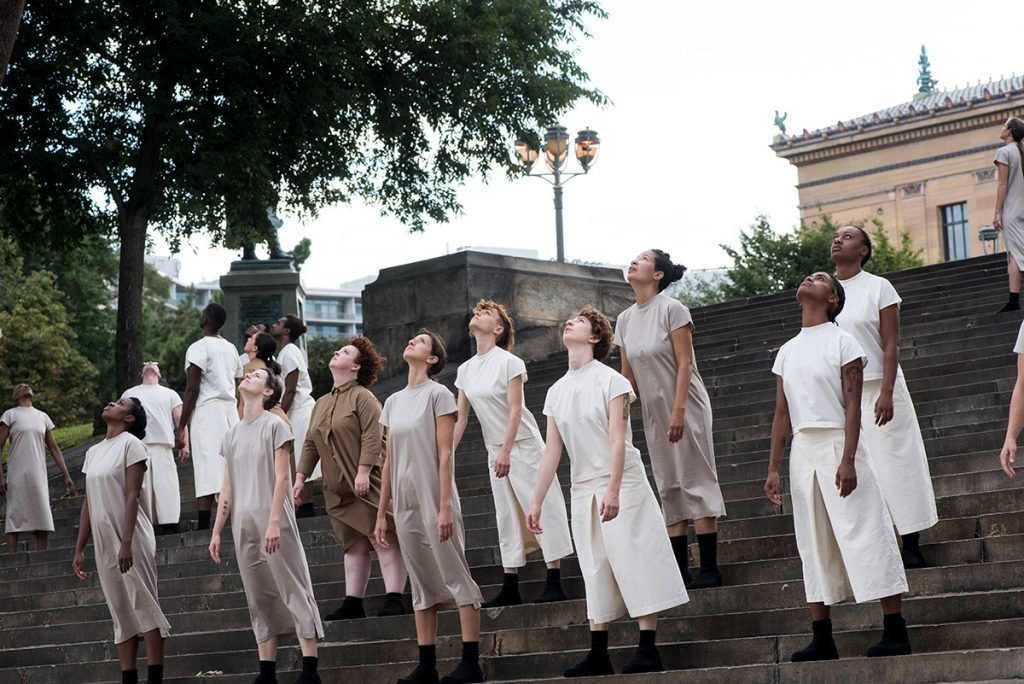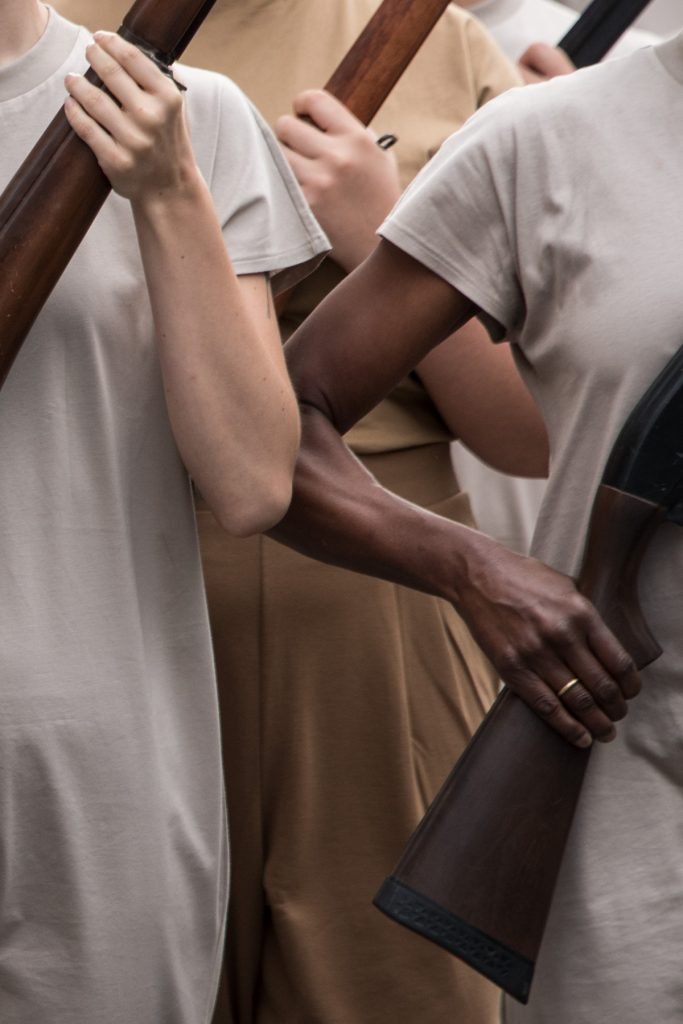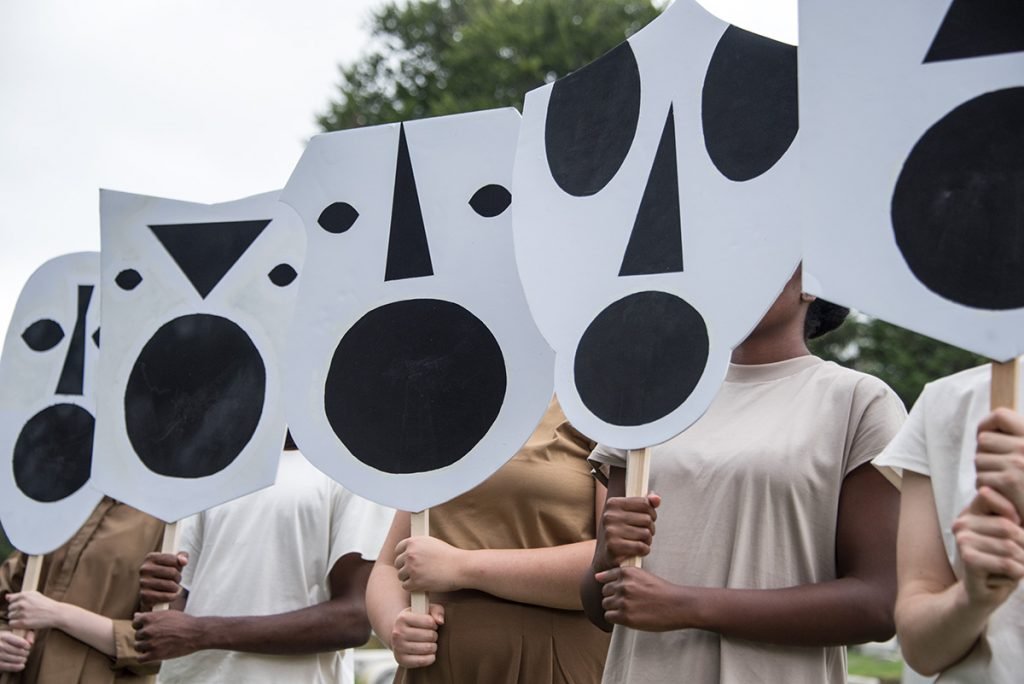The title stems from the large neon work Patriarchy is History (2019), a direct and eloquent statement prompted not only by most recent events and discourses, but as a systemic reality of global History. This new work is yet another outcome of the artist’s ongoing interdisciplinary project What if Women Ruled the World? (2017–present).
At Galleria Raffaella Cortese Bartana presents, for the first time in Italy, her recent video work The Undertaker. Filmed in Philadelphia, the birthplace of American democracy and location of the artist’s solo show at the Philadelphia Museum of Art in 2018, the work generates from the public performance Bury Our Weapons, Not Our Bodies!; a public ceremonial march mourns at a funeral lead by a mysterious leader. Sternly holding weapons, the crowd strides through the streets of the city towards Laurel Hill Cemetery, where the burial of the weapons takes place. Inspired by military processions as war celebrations, the project came into being within a reality which celebrates the right to bear arms and use them. Reacting to the second amendment of the US constitution, the ritual assumes a strong meaning as a call for the end of the destructive gun culture. Global symbols of perpetuation of violence and subject of large and poignant discussions on public policy in the Western world, the imagery of weapons hold a renewed symbolic power. The performance in Philadelphia was inspired by the choreography of Israeli movement-composer Noa Eshkol (1924–2007) from 1953.
The artist also presents works that are able to sublimate some of the moments of The Undertaker. Shot during the performance, and now for the first time showed to the public, the photographic series investigates the several nuances of gestures, elements and symbols that make up the action. The displaced composition on the wall recalls classic and modern painting collections, and acts as a current investigation by Bartana on the way to present photography. The same space also shows museum-like display cases which preserve uncanny “fossils” of weapons from different times in history – the very same firearms that the moving crowd depicted in the performance hold in procession. These “future-past” artefacts catch our eyes as silent witnesses of an apparently archaic age, and yet, attesting a present reality of violence, they suggest an imaginary and speculative future which depends on the potential action of governments and individuals worldwide.


1, 2 – Bury Our Weapons, Not Our Bodies!, 2018 Color photograph; 20 × 30 cm Ed. 5 + 2 AP
3, 5, 7, 8, 11, 12 – Bury Our Weapons, Not Our Bodies!, 2018 Color photograph; 30 × 45 cm Ed. 5 + 2 AP
4, 6, 9, 10 – Bury Our Weapons, Not Our Bodies!, 2018 Color photograph; 45 × 30 cm Ed. 5 + 2 A
13, 14, 15, 16, 17, 18, 20, 21 – Bury Our Weapons, Not Our Bodies!, 2018 Color photograph; 45 × 67,5 cm Ed. 5 + 2 AP
19 – Bury Our Weapons, Not Our Bodies!, 2018 Color photograph; 67,5 × 45 cm Ed. 5 + 2 AP
ph: exhibition views by t-space studio
In times of inner conflict, of revaluation of basic and necessary aspects of life and freedom, and of an ever-growing sense of not belonging to shared systems, Yael Bartana’s work comes as a precious breath of fresh air. The art and the artist play the fundamental role that for centuries has characterized the best instances thanks to the possibility of imagining different scenarios to be able to test them through questions and points for reflection, without any need of acceptance or belonging and therefore free not to submit to any rule, annoying and accusing openly.
The works on display, as well as all the artistic practice of Bartana, make clear the fascination of the artist exerted by the possibility of representing stories and events through typical dynamics of ideological propaganda, capable of transmitting meanings and ideas through the use of images. The will to take as an example the practices adopted by the political propaganda applied in Europe during the thirties, and to reverse its use using the same rhetorical apparatus showing all its dangerousness, characterize all the work of the artist. The interest in the reversal of historical narratives is in fact already found in the films of her Polish Trilogy (Nightmare, 2007, Wall and Tower, 2009 and Assassination, 2011) where, at this reversal, an imaginary and theatrical scenario is inserted as a methodology to comment on current reality.
This aspect, particularly evident in works such as What if Women Ruled the World?, returns forcefully also in Patriarchy is History. The analysis of the possibilities created by a gender change in roles occupied almost exclusively by male figures passes through a visual overturning that makes immediate change, destabilizing, through the use of know imaginaries. Bartana thus uses settings that are based on the War Room of Stanley Kubrick in Dr. Strangelove, place in which men hold and exercise power, to populate it with an all-female government with the aim of better analyzing the current situation.
A recognizable visual component within which a distortion element is inserted, creating a sort of disharmonious musical chord that the ear, even untrained, is able to immediately perceive as non-aligned, abnormal.
Yael Bartana’s work, however, does not stop at a destabilization through the inversion of roles, what we have to think about is that if we really want to experience a transition from a patriarchal world to a matriarchal one, it should not follow the typical binary structures of male power but, rather, it should implement new ones by building a system of plurality in which the woman does not play the role of ‘other’, ‘non-man’.
What if Women Ruled the World? is therefore a place of ideas where to think about the break with the existing models, in which is inserted this new chapter proposed with Patriarchy is History.
In this Italian exhibition perceives how the attention of the artist is always to return a story as complete as possible, using different media, able to express in different and complex ways the topic and the process of mental elaboration in course from years. Moving from The Undertaker” video to exposed photographs taken during the performance, or the sculptural elements exhibited in plexiglass cases we can see that the main element of these works are weapons as fetish object, phallic shaped, as representation of domination and power.
The thought then returns to the scenes of Dr Strangelove in which a nuclear attack is launched in response to the sexual impotence of one of the generals, (reference several times used by the artist during her interviews) or to the more contemporary tweets of the American president Donald Trump in which he discusses with the North Korean Kim Jong Un on who could have the biggest button.
At the same time, the sculptural elements of weapons proposed as archaeological remains, give us the feeling of witnessing a history now completed to which, from the future in which we observe, we should be able to provide answers.
ph: (1 – 2 – 3) by t-space studio
Yael Bartana was born in 1970 in Kfar Yehezkel, Israel. She currently lives and works in Amsterdam and Berlin.
Yael Bartana’s films, installations, sculptures, and photographs explore the imagery of identity and the politics of memory. Her starting point is the national consciousness propagated by her native country, Israel. Central to the work are meanings implied by terms like “homeland”, “return” and “belonging”. Bartana investigates these through ceremonies, public rituals and social diversions that are intended to reaffirm the collective identity of the nation state.
In her Israeli projects, Bartana dealt with the impact of war, military rituals and a sense of threat on every‑day life. Between 2006 and 2011, she worked in Poland, creating the trilogy And Europe Will Be Stunned, a project on the history of Polish-Jewish relations and its influence on the contemporary Polish identity. The trilogy represented Poland at the 54th International Art Exhibition in Venice (2011).
A number of solo exhibitions have been devoted to Bartana, including: Yael Bartana. Cast Off, Fondazione Modena Arte Visive, Modena (2019); And Europe Will Be Stunned, Philadelphia Museum of Art, Philadelphia (2018); What if Women Ruled the World, Manchester International Festival, Manchester and Aarhus 2017 European Capital of Culture Aarhus (2017); Trembling Times, Musée cantonal des Beaux-Arts, Lausanne (2017); On Cohabitation, The Banff Centre, Alberta (2016); Wenn Ihr wollt, ist es kein Traum, Secession, Vienna (2012); …and Europe will be stunned, Moderna Museet, Malmö (2010); Trembling Time, Kings of the Hill, PS1, New York (2008).
She has also taken part in several group exhibitions, among which: Histories of Women / Feminist Histories, MASP / Casa de Povo, Sao Paulo (2019); Reality… is more absurd than any film, Marta Herford Museum, Herford (2019); The Street. Where the World is Made, MAXXI, Rome (2018); Freedom of Movement, Stedelijk Museum, Amsterdam (2018); Scenes from the Collection, Jewish Museum New York (2018); Place Relations, CEPA Gallery, Buffalo (2017); The Body Extended: Sculpture and Prosthetic, Henry Moore Institute, Leeds (2016); Summer guests, Calouste Gulbenkian Foundation, Lisboa (2016); How to (…) things that don’t exist, Serralves Museum of Contemporary Art, Porto (2015); La disparition des lucioles, La Collection Lambert, Avignon (2014); Carnegie International, Carnegie Museum of Art, Pittsburgh (2013).
In 2005 she took part in the 9th Istanbul Biennial; in 2012 the 7th Berlin Biennial; in 2014 the 19th Biennale of Sydney and the 31st Sao Paolo Biennial. In 2011 she represented Poland in the 54th Venice Biennale.















